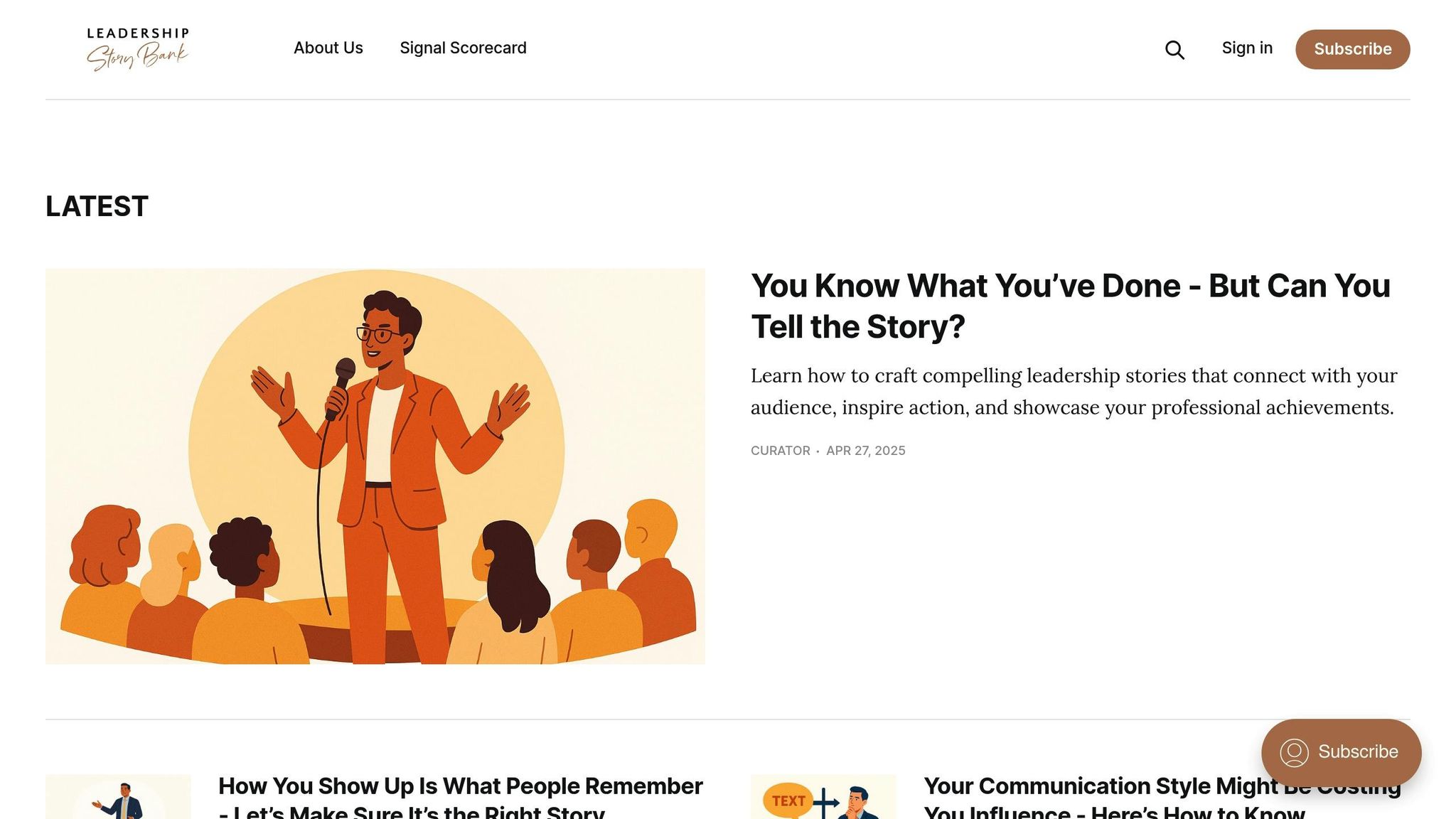What’s Your Leadership Communication Style - and What Is It Costing You?
Explore how your leadership communication style impacts team performance and discover strategies for improvement to enhance productivity and trust.

Did you know poor leadership communication can cost companies thousands per employee annually? Leaders who fail to adapt their communication style to their team and situation risk wasted time, reduced productivity, and higher turnover rates.
Here’s what you need to know:
- Identify your style: Are you assertive, empathetic, analytical, relational, or intuitive? Each style has strengths and limitations.
- Be self-aware: Use the "Prepare – Consider – Flex – Reflect" framework to evaluate and improve your communication habits.
- Adapt to the situation: Effective leaders adjust their style based on urgency, team dynamics, and complexity of the message.
- Avoid costly mistakes: Missteps like unclear direction or avoiding tough conversations can waste over 7.5 hours per employee weekly, costing up to £10,000 per person annually.
Improving your communication isn’t just about talking more - it’s about listening better, adapting appropriately, and building trust. Start by assessing your default approach, seeking feedback, and practising flexibility. Better communication leads to stronger teams and measurable business results.
Is Your Communication Style Holding Back Your Career?
Finding Your Communication Style
Understanding your leadership communication style can make you a more effective leader.
5 Main Leadership Communication Types
| Style | Key Traits | Ideal for | Potential Limitations |
|---|---|---|---|
| Assertive | Clear, confident, respectful | Making decisions, setting direction | May come across as too direct in sensitive situations |
| Empathetic | Understanding, validating, supportive | Building relationships, resolving conflicts | Could prioritise emotions over achieving goals |
| Analytical | Detail-oriented, logical, systematic | Problem-solving, strategic planning | Might seem detached or overly unemotional |
| Relational | Collaborative, inclusive, harmonious | Team building, fostering engagement | May avoid necessary confrontations |
| Intuitive | Quick-thinking, balanced | Crisis management, spotting opportunities | Could act too quickly without sufficient data |
Determine Your Primary Style
To identify your dominant communication style, reflect on your real-life interactions.
Self-Assessment Framework
Consider these scenarios to analyse your approach:
-
Team Meetings
Do you focus more on data and facts or on building relationships during discussions? -
Decision-Making
Examine how you make decisions. Do you rely on intuition, or do you prefer detailed analysis? -
Conflict Resolution
How do you handle disagreements? Are you direct and assertive, or do you aim for harmony and compromise?
These observations can help you recognise patterns in your communication style and refine your approach.
"Communicating doesn't have to be a competition or a conflict. Honesty is important, but so is communicating in a way that your message gets heard."
– Kristen Hamling, Ph.D., Professional Psychologist, Facilitator, Coach
Practical Assessment Tips
- Record team interactions to evaluate your communication style objectively.
- Seek feedback from trusted colleagues on how they perceive your approach.
- Pay attention to how your team responds to different communication methods.
While most people have a dominant style, effective leaders adjust their approach based on the situation. Research shows that managers who adapt their communication style see a 37% increase in team engagement scores.
Recognising your default style is just the beginning. The ability to adjust and use different styles when needed will help you communicate authentically while staying effective.
Hidden Costs of Poor Communication
Poor communication from leadership can lead to serious financial and organisational challenges. Let’s break down some common mistakes and how they contribute to these hidden costs.
Common Mistakes and Their Effects
On average, ineffective communication results in about 7.5 hours of wasted time per employee every week. This loss often stems from recurring leadership missteps:
Avoiding Difficult Conversations
Dodging tough discussions creates uncertainty, encourages rumours, and damages trust among team members.
Inconsistent Messaging
"When key players are not communicating well, decision-making is delayed, and problems become more difficult to address. Defensiveness, the need to be right, and emotional overreactions get in the way of solutions. These delays have a trickle-down effect, interfering with the implementation of strategic goals. Innovation cannot be a priority when there is limited collaboration and trust."
One-Way Communication
Leaders who don’t actively listen risk alienating their teams and missing valuable input.
Cost Table: Mistakes vs Results
The financial consequences of poor communication are clear. Below is a breakdown of how specific communication failures lead to measurable costs:
| Communication Error | Immediate Effect | Annual Financial Impact |
|---|---|---|
| Unclear Direction | 7.47 hours lost per week per employee | £10,005 per employee* |
| Poor Change Management | Higher staff turnover | 18% of total salary costs |
| Ineffective Team Meetings | Reduced productivity | £20,010 per senior employee** |
| Delayed Decision-Making | Missed opportunities | Variable project delays |
*Based on the average UK knowledge worker salary
**For employees earning higher salaries (£107,162)
These costs, both direct and indirect, underline the need for better communication practices. Recognising these impacts is the first step toward addressing the issues.
"Since communication is woven through almost every aspect of your organisation, all problems and concerns will expand exponentially when leadership or employees cannot express themselves effectively. When communication skills are limited, organisational and interpersonal problems will continue to plague your company and cost you money. That's the bottom line." – Debra Roberts
Beyond the financial toll, poor communication stifles innovation, reduces engagement, and harms workplace culture. In fact, research shows that over 80% of business leaders estimate revenue losses of at least £8,000 or more due to communication inefficiencies.
Improving Your Communication Style
Boost your leadership communication with these practical strategies.
Steps to Better Communication
Understanding your communication habits is the first step towards improvement. Leaders who actively refine their communication skills often see better team performance and stronger engagement.
Conduct an Honest Self-Assessment
Take a close look at how you communicate. Review recent conversations to spot recurring issues. Harvard Business Review recommends using metaphors to make abstract ideas easier to grasp: "When you introduce a new or abstract idea, your audience will automatically search for something familiar to help them make sense of it. Introduce a novel metaphor and beat them to the punch."
Develop Emotional Intelligence
Good communication isn’t just about the words you use - it’s also about emotional awareness. Focus on these three areas:
| Component | Development Focus | Expected Outcome |
|---|---|---|
| Self-awareness | Track your emotions during conversations | Improved timing and message clarity |
| Self-control | Pause before responding instead of reacting | Fewer misunderstandings |
| Social awareness | Pay attention to non-verbal cues | Better team engagement |
Master Active Listening
Active listening is key. Summarise key points during discussions to confirm mutual understanding. Use feedback to fine-tune your listening skills over time.
Using Feedback for Growth
"Knowing your personal communication style - and adapting that style to the needs of your team - will help avoid misunderstandings and keep your team operating at peak effectiveness."
Structured Feedback Collection
Make feedback a regular part of your routine with these methods:
- Anonymous surveys: Encourage honest, unfiltered input from your team.
- One-to-one check-ins: Create space for open, direct conversations.
- Post-meeting reflections: Collect immediate thoughts and impressions.
Adapt Your Approach
Different scenarios require different communication styles. Here’s how to tailor your approach:
| Communication Style | Best For | Key Benefits |
|---|---|---|
| Direct | Time-sensitive decisions | Clear outcomes, faster action |
| Functional | Complex processes | Detailed understanding |
| Collaborative | Team alignment | Stronger buy-in |
| Influencer | Managing change | Builds emotional connections |
Harvard Business Review also suggests making your mission a central focus to keep teams aligned. This helps you stay consistent while adjusting your style as needed.
Professional Development
Invest in professional development to gain fresh perspectives, learn new techniques, and receive expert guidance to refine your communication skills.
Matching Style to Situation
Rules for Flexible Communication
Tailoring your communication style to fit the situation can significantly boost team performance.
Assess the Situation
When deciding how to communicate, consider these factors:
| Context Factor | What to Consider | Example Adjustment |
|---|---|---|
| Urgency Level | How time-sensitive is the matter? | Use a direct approach during crises or deadlines. |
| Team Dynamics | Team experience and autonomy levels | Offer guidance and coaching to newer team members. |
| Cultural Context | Diversity and preferences | Adjust your formality to respect cultural norms. |
| Message Complexity | Depth and scope of the content | Simplify technical details for mixed audiences. |
Use Situational Leadership
The Situational Leadership® model outlines four key approaches leaders can take:
-
Directive Style
Provide clear, straightforward instructions for quick decisions or when working with less experienced teams. -
Coaching Style
Offer guidance and support to help team members build their skills and confidence. -
Supportive Style
Collaborate closely with experienced team members, fostering a sense of partnership. -
Delegation Style
Grant autonomy to highly skilled professionals who can work independently.
"Being a great leader means recognizing that different circumstances may call for different approaches." - Daniel Goleman, Psychologist
Leadership Story Bank Resources

To help leaders communicate effectively in different situations, Leadership Story Bank provides these practical tools:
| Tool Type | Purpose | Key Benefits |
|---|---|---|
| Scenario Simulations | Safe practice for adapting styles | Build confidence in switching communication styles. |
| Communication Templates | Pre-structured message formats | Maintain clarity and consistency. |
| Feedback Framework | Collect input on communication success | Identify areas for improvement. |
Emotional Intelligence in Communication
Emotional intelligence is essential for adapting communication styles. Focus on these areas:
- Monitor team emotions during discussions to adjust your approach.
- Adapt tone and delivery based on team feedback.
- Practice active listening to ensure clarity and understanding.
- Build trust through open and transparent dialogue.
Practical Tips
Make these strategies part of your routine when facing challenges:
- Establish clear communication protocols that allow for flexibility.
- Use a mix of visual, auditory, and interactive methods in presentations.
- Create a safe environment where team members feel comfortable sharing concerns.
- Regularly check in to evaluate how well communication strategies are working.
Adapting your communication style doesn’t mean changing your message - it’s about ensuring it resonates with your audience and suits the situation.
Conclusion: Next Steps for Better Communication
Improving leadership communication is an ongoing process that requires dedication and effort.
Create Your Communication Development Plan
Focus on these key areas to strengthen your leadership communication:
| Development Area | Action Steps | Expected Outcome |
|---|---|---|
| Self-Assessment | Use the "Prepare – Consider – Flex – Reflect" checklist before important conversations | Better self-awareness and more effective adjustments |
| Active Feedback | Hold regular feedback sessions with your team | Useful insights to refine your approach |
| Style Adaptation | Practise shifting communication styles based on different situations | Improved ability to connect with diverse audiences |
| Skill Building | Participate in communication workshops or coaching | Broader set of communication skills |
Incorporate these steps into your routine to see lasting improvements.
Practical Implementation
Start by observing your communication during team meetings. Take note of your default style, how your team reacts, where misunderstandings occur, and what works well. This will give you a clearer picture of your strengths and areas that need attention.
Research on emotional intelligence shows the importance of self-awareness and understanding others' emotions. These skills help you adjust your communication style to match the needs of your team and the situation, making your interactions more effective.
Building Long-term Success
Use these practical steps as a foundation to continually refine your communication. Aim for a style that’s flexible yet stays true to who you are as a leader. Regularly evaluate your impact, seek feedback, and adjust as needed. Over time, this consistent effort will sharpen your leadership voice, helping you maximise your strengths and address any challenges. With practice and reflection, you'll build a communication style that resonates and drives results.
FAQs
How can I identify the best leadership communication style for my team and situation?
To find the most effective leadership communication style for your team and situation, start by assessing your own natural approach. Consider how it aligns with the needs of your team and the specific circumstances you’re addressing. Reflect on whether your style fosters clarity, connection, and understanding.
Adaptability is key. Different scenarios may require you to adjust your tone, level of detail, or emotional approach. For example, a high-pressure situation might call for concise and assertive communication, while a collaborative project may benefit from a more open and inclusive style.
Regularly seek feedback from your team to understand how your communication is received and where adjustments may be needed. This will help you refine your style to better resonate with your team and achieve your leadership goals.
How can I enhance my leadership communication and avoid the hidden costs of poor communication?
Improving your leadership communication can significantly enhance your effectiveness and reduce the hidden costs of miscommunication, such as misunderstandings or strained relationships. Start by developing self-awareness: reflect on your communication style and ask for constructive feedback from your team. This will help you identify areas for improvement.
Practise active listening by fully focusing on what others are saying, ensuring you understand their message before responding. Combine this with empathy, considering your team members' emotions and perspectives to foster trust and connection. Finally, strive for clarity in your messages, avoiding unnecessary complexity or over-explaining, and adapt your style to suit the situation and audience. Small, consistent improvements can make a big difference in your leadership impact.
How can emotional intelligence help me adapt my communication style to suit different team dynamics and situations?
Emotional intelligence (EQ) is a key skill for tailoring your communication style to fit various team dynamics and situations. By understanding and managing your own emotions, while also recognising and responding to the emotions of others, you can build stronger relationships, foster trust, and inspire your team more effectively.
Leaders with high EQ are better equipped to adapt their approach, whether it's being more empathetic during challenging times or using clear, decisive communication when quick decisions are needed. Core EQ competencies such as self-awareness, empathy, and social skills enable you to connect with your team and adjust your style to achieve the best outcomes. A flexible approach to communication ensures you can lead with greater influence and impact, no matter the situation.



